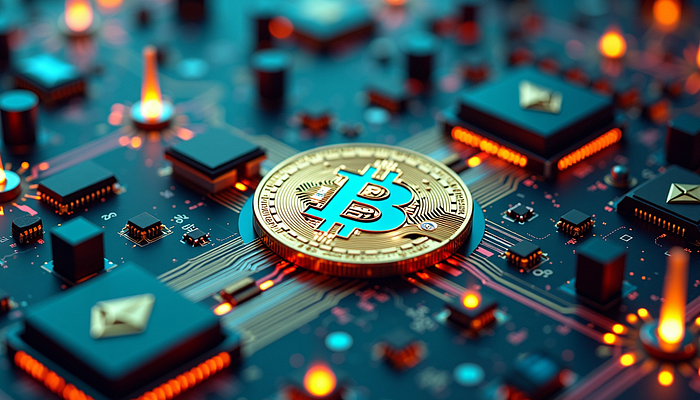Why are Bitcoin miners trading crypto for AI?
As demand for AI compute surges, miners have found a new way to monetize their high-powered ASIC investments

Bitcoin miners are shedding their dependence on network transactions and re-jigging operations to serve the intensive computing requirements of generative AI.
Revenue diversification, higher profit margins, AI’s growth trajectory, plus the natural synergies between Bitcoin mining and LLM’s all factor in, but the real reason for the pivot is Bitcoin’s 2024 network halving. It slashed block rewards and, as such, the profitability of many mining operations.
Left with added exposure to BTC price volatility and rising difficulty levels on the blockchain, some miners have decided to rethink their business models.
Strategic opportunity, revenue necessity
A Bitcoin mining operation has a lot in common with a traditional data center. Both fill warehouses with rows of heavy duty computing kit and smoke massive amounts of energy.
Turning mining facilities into AI hosting centers is already happening. Bitcoin mining companies like Core Scientific are doing just that — providing HPC hosting services for generative AI firms.
In June 2024, Core Scientific announced that it would modify a part of its infrastructure to host cloud graphics processing unit (GPU) provider CoreWeave’s Nvidia GPU chips for HPC operations.
The Nasdaq-listed Bitcoin miner said:
“We are a hosting provider of choice to our clients because we own our flexible, high-power infrastructure and have a team of highly experienced data center experts who can execute and build rapidly and effectively.”
Bit Digital has taken a different tack, offering its GPUs for rent to AI customers.
When Bit Digital first announced its AI venture in October 2023, CEO Sam Tabar called it an “excellent expansion of our platform,” once again highlighting the synergies between Bitcoin mining and AI infrastructure.
Mitigating the impact of BTC price volatility
Tabar also mentioned that Bit Digital’s AI-focused business will help provide “a non-correlated income stream” and help the company “weather potential downturns in its core bitcoin mining and ETH staking businesses.”
Bitcoin mining is a cyclic business that is heavily dependent on the market prices of Bitcoin. Adding to the complexity is Bitcoin’s difficulty adjustment where the protocol is coded to make Bitcoin mining more difficult as more miners enter the field.
When you add other uncertainties and complications like Bitcoin halving, crypto regulations, and intense competition in the mining sector, you see the complex landscapes that Bitcoin miners have to navigate.
The new focus on AI will protect miners from Bitcoin market downturns and provide predictable income from an industry expected to experience meteoric growth.
Leaping on to LLMs
AI is on the up and miners are keen to get in on the action. According to PwC, AI is expected to contribute up to $15.7 trillion to the global economy in 2030. For context, this figure is more than the current gross domestic product (GDP) of Germany, Japan, and India combined.
Meanwhile, global investment firm KKR predicted that AI’s enormous appetite for data and processing will shift data center workloads over the next decade. According to KKR, AI accounted for 30% of hyperscale data center workload in 2024. This figure is expected to reach 50% by 2030. KKR wrote:
“Networks of data centers are like a new utility, housing the entire value chain of the digital economy. They support the production of massive amounts of new data, similar to farming and mining in the physical economy; they refine and analyze data to produce something new, like manufacturers, and they help to distribute data across transmission networks, like logistics hubs and warehouses.”

Will Bitcoin face a mining shortage?
Will Bitcoin miners make a full pivot to AI computing? According to CoinShares Research, the two sectores have different energy and internet uptime needs.
AI computing requires extremely high uptime (typically 99% or higher), as downtimes can delay the resumption of prior processing activities for extended periods.
Contractual penalties are often agreed upon to prevent these downtimes.
Bitcoin mining, on the other hand, can be powered on and off within minutes to resume operations, making it ideal for locations with less reliable energy.
CoinShares added that miners at “energy-secure locations” have shown a growing preference for AI over Bitcoin mining. They wrote:
“Looking ahead, it is conceivable that Bitcoin mining could become predominantly based at energy-insecure stranded energy sites, especially where it can subsidize such energy projects financially. Conversely, miners seeking revenue diversification and potentially higher margins are likely to invest in AI, exacerbating this divergence.”
The take away
Bitcoin miners are adapting to changing conditions in order to survive and thrive. Just as investor favorite AI play Nvidia (NVDA) changed over the years from catering primarily to the gaming industry to powering AI innovations today, Bitcoin miners could follow a similar trajectory.
-30-

